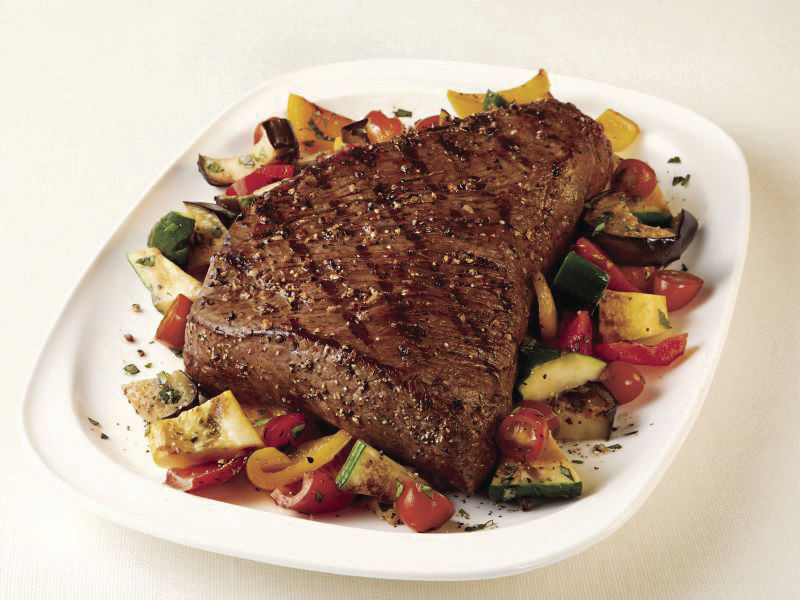There’s something about the charbroiled flavor of barbecued food that makes it taste extra special. Maybe it owes part of its appeal to the fresh air that sharpens the appetite and makes that tantalizing aroma so totally irresistible. It’s even better when the aroma is coming from your yard and not someone in your neighborhood’s yard.
There’s nothing new about cooking over charcoal. In fact, it’s a method of cooking that has been used in most civilizations throughout history. In the early years, cooking over wood or charcoal was a necessity. Nowadays, it’s a luxury. The basic method has changed little over the centuries, but the introduction of the modern grill has made this backyard activity a little easier.
Modern grills range from the basic charcoal bowl-type grill to the state-of-the-art gas grill. Get a whiff of the apple wood smoke coming from a grill and you’ll know it has the capability to cook multiple ways.
May is Beef Month in Kansas so the focus of this story is beef. Succulent cuts of meat are often the starting point when planning a meal cooked on the grill. Choosing the right cut and grade of meat can sometimes be mindboggling. Certified Angus Beef brand explains that the USDA inspects all U.S. beef for wholesomeness, and most beef is graded for additional quality standards. USDA grading is a voluntary process that categorizes beef, predicts its quality and helps the industry and consumers determine its value.
When it comes to quality grades, the main difference lies in the amount of marbling within the meat. Typically, more marbling equals a higher USDA grade. Marbling, or the tiny white flecks scattered throughout the lean red meat, gives beef its great taste and keeps it tender and juicy while cooking. Beef with higher degrees of marbling usually earns a better quality grade which includes prime, choice and select. Most retailers offer the choice and select grades of meat, with select having a noticeable reduction in tenderness, juiciness and flavor.
When it comes to cuts of meat your taste buds and wallet may drive your selection. Rib eye, one of the most tender steaks, is my favorite. It is generously marbled and has a robust beef flavor. Other cuts in my grocer’s cooler today include beef tenderloin steaks, the most tender of the cuts, and the tri-tip roast. The Beef Its What’s For Dinner website provided two recipes we tested with an impressive outcome.
The simplest marinade will work wonders, improving the texture and juiciness of the meat as well as adding flavors of herbs and spices. Charbroiling gives meat a unique flavor while smoking the meat prior to grilling gives the flavor a boost.
Garden Grill Tri-Tip
Source: www.beefitswhatfordinner.com
Ingredients:
1 beef Tri-Tip Roast (about 1-1/2 to 2 pounds)
1 small eggplant, cut crosswise into 1/2-inch thick slices
2 small red and/or yellow bell peppers, cut lengthwise into quarters
2 medium yellow squash and/or zucchini, cut lengthwise in half
1 cup grape tomatoes, cut in half
1/4 cup lightly packed chopped fresh basil
Salt and ground black pepper
Marinade:
Sign up for HPJ Insights
Our weekly newsletter delivers the latest news straight to your inbox including breaking news, our exclusive columns and much more.
1/3 cup olive oil
1/3 cup dry white wine
2 Tbsp. fresh lemon juice
1 Tbsp. minced garlic
Directions:
1. Combine marinade ingredients in small bowl. Place beef roast and 1/3 cup marinade in food-safe plastic bag; turn roast to coat. Close bag securely and marinate in refrigerator 15 minutes to 2 hours, turning occasionally. Cover and reserve remaining marinade in refrigerator.
2. Remove 1/4 cup of reserved marinade for ratatouille; set aside. Toss vegetables (except tomatoes) with remaining marinade.
3. Remove roast from marinade; discard marinade. Place roast in center of grill over medium, ash-covered coals or over medium heat on preheated gas grill; arrange vegetables (except tomatoes) around roast. Grill roast, covered, 25 to 35 minutes for medium rare (145 degrees F) to medium (160 degrees F) doneness, turning occasionally. Grill eggplant and bell peppers 7 to 11 minutes; zucchini and yellow squash 8 to 12 minutes (on gas grill, eggplant 6 to 8 minutes; bell peppers, zucchini and yellow squash 7 to 11 minutes) or until tender, turning occasionally.
4. Remove roast when instant-read thermometer registers 135 degrees F for medium rare; 150 degrees F for medium. Transfer roast to carving board; tent loosely with aluminum foil. Let stand 10 minutes.
5. Meanwhile, cut grilled vegetables into 1-inch pieces. Combine vegetables, tomatoes, basil and reserved 1/4 cup marinade in large bowl; toss to coat. Carve roast diagonally across the grain into thin slices. Season roast and ratatouille with salt and black pepper, as desired.
Beef Filets with Ancient Grain and Kale Salad
Source: www.beefitswhatfordinner.com
Ingredients:
2 beef Tenderloin Steaks, cut 1 inch thick (about 6 ounces each)
1/4 plus 1/8 teaspoon cracked black pepper, divided
Salt
3 cloves garlic, minced, divided
1 cup reduced-sodium beef broth
1/2 cup pearlized farro
1 cup thinly sliced kale
1/4 cup dried sweetened cranberries or cherries
2 tablespoons sliced almonds
2 teaspoons fresh lemon juice
Directions:
1. Combine 1 clove garlic and 1/4 teaspoon pepper; press evenly onto beef steaks.
2. Combine beef broth, farro, remaining 2 cloves garlic and remaining 1/8 teaspoon pepper in small saucepan. Bring to a boil; reduce heat to low. Cover and simmer 15 to 20 minutes or until most broth has been absorbed. Remove from heat. Stir in kale and cranberries. Cover; let stand 5 minutes. Stir in almonds and lemon juice. Season with salt, as desired.
3. Meanwhile, place steaks on rack in broiler pan so surface of steaks is 2 to 3 inches from heat. Broil 13 to 16 minutes for medium rare (145 degrees F) to medium (160 degrees F) doneness, turning once.
4. Season steaks with salt. Serve with farro mixture.




